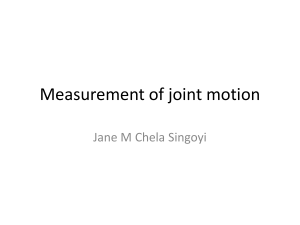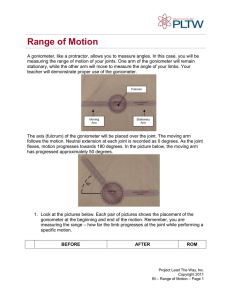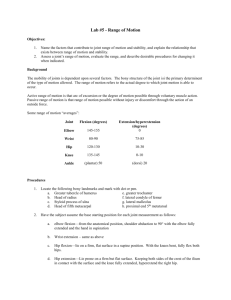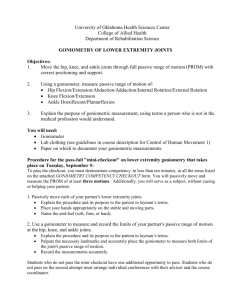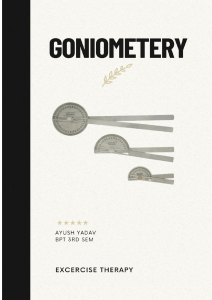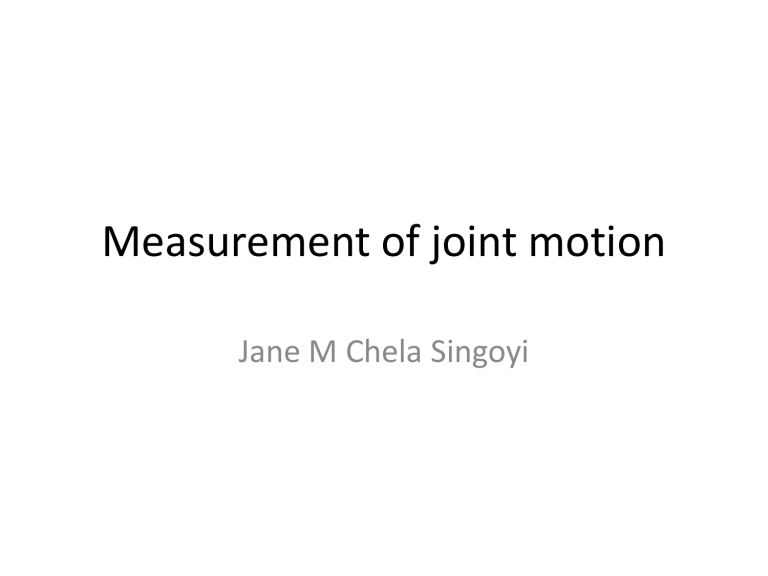
Measurement of joint motion Jane M Chela Singoyi Introduction Measurement of joint motion is an important part of the physical examination. For a measurement to have value, it must be reliable and valid. Many decisions regarding patient status, treatment and prognosis are based partly or wholly on measurements of joint motion. Range of motion is the measurement of how much range is available at a joint. Introduction • The measurement of possible movement at any joint is known as Goniometry. It is method used to measure joint motion. • The term goniometry is derived from two Greek words, gōnia, meaning angle, and metron, meaning measure. • Since movement at any joint is angular, the unit ‘degrees’ when measuring ROM rather inches or millimeters is used. • Range of motion can be measured as active or passive. Passive range is always greater than active. Tools for measuring joint range • Joint range of motion can be measured using goniometers, inclinometers and hygrometers. The commonest and easiest to use in practice is the goniometer. • A traditional goniometer comprises of a protractor and two extending arms, a movable one and an immovable arm. The movable arm is attached to the protractor on the fulcrum. Principles of joint measurement • All movements of a joint are measured from defined Zero starting position. Thus, the degrees of motion are added in the direction the joint moves from the zero starting position. • The extended anatomical position of an extremity is accepted as zero degrees, rather than 180 degrees. • The motion of the extremity being examined should be compared to that of the opposite extremity. Principles continued • If the opposite motion is not present, the motion should be compared to the average motion of an individual of similar age and physical build. • A distinction is made between the terms extension and hypertension. Extension is used when the motion is opposite to flexion, at the zero starting position, is a natural motion. E.g. at the wrist joint. If however, the motion opposite to flexion at the zero starting position is unnatural one, such as that of the elbow or knees, it is referred to as hyperextension. Picture of a goniometer • The body of the goniometer is designed like a protractor and may form a full or half circle. A measuring scale is located around the body. The scale can extend either from 0 to 180 degrees and 180 to 0 degrees for the half circle models, or from 0 to 360 degrees and from 360 to 0 degrees on the full circle models. The intervals on the scales can vary from 1 to 10 degrees. Usually 0 degrees corresponds with the joint placed in anatomic position • The stationary arm is structurally a part of the body and therefore cannot move independently of the body • The moving arm is attached to the fulcrum in the center of the body by a rivet or screw-like device that allows the moving arm to move freely on the body of the device. How to use the goniometer 1. The patient is positioned in the recommended testing position. While stabilizing the proximal joint component, the clinician gently moves the distal joint component through the available range of motion until the end feel is determined. An estimate is made of the available range of motion and the distal joint component is returned to the starting position. Ensure that the other joints are stabilized. 2. The clinician palpates the relevant bony landmarks and aligns the goniometer parts with the bony landmarks. Mark the points for the fulcrum and axes for the goniometer arms on the patient. 3. A record is made of the starting measurement. 4. The goniometer is then removed and the patient moves the joint through the available range of motion. Once the joint has been moved through the available range of motion, the goniometer is replaced and realigned, and a measurement is read and recorded. ***Talk about documenting normal and limited range*** There are generally certain items which need to be documented when measuring the range of motion of a patient’s joints. a. Whether the motion was tested actively or passively. b. Whether the right or left side was being tested c. The joint that was being tested. d. The movement that was being tested e. The position the patient was in during measurement f. The starting position in degrees g. The ending position in degrees h. Whether or not there was pain Normal ranges of motion for the larger joints JOINT Shoulder Elbow Forearm Wrist Hip Knee Ankle Foot ACTION Flexion Extension Abduction Internal rotation External rotation Flexion Pronation Supination Flexion Extension Radial deviation Ulnar deviation Flexion Extension Abduction Adduction Internal rotation External rotation Flexion Plantarflexion Dorsiflexion Inversion Eversion DEGREES OF MOTION 0-180 0-40 0-180 0-80 0-90 0-150 0-80 0-80 0-60 0-60 0-20 0-30 0-100 0-30 0-40 0-20 0-40 0-50 0-150 0-40 0-20 0-30 0-20 End feels • When assessing the passive movement, the examiners should apply overpressure at the end to determine the end feel. End feel is the sensation the examiner feels in the joint as it reaches the end of the passive range of motion. • Types of end feels a. Normal end feel / Physiological – the joint has full range of motion and the movement is stopped by the anatomy of the joint. 3 classical normal end feels i. Bony/hard end feel – this is a hard, unyielding, abrupt sensation that is painless. This is when motion is stopped by two bones contacting one another. An example is the end feel for extension of the elbow. ii. Soft tissue approximation soft end feel) - This is the end feel in which motion is stopped by two masses of soft tissue pressing on one another. Tissue meets tissue and it is painless. An example is in flexion of the elbow, in which the elbow flexors and knee flexors press on each other to limit further motion. iii. Firm/tissue stretch – there is a firm springy or rubbery type of movement with a slight give towards the end of the ROM – normal elastic resistance that is felt when stretching soft tissue e.g. lateral flexion of the cervical spine. iv. Capsular stretch - A hard arrest to the movement that has some give when the joint capsule stretching a piece of leather. For example, it occurs in passive shoulder external rotation. or ligaments are stretched. The feel is similar to b. Abnormal/pathological end feels • Hard - An abrupt hard stop to movement occurs when bone contacts bone or a bony grating sensation when rough articular surfaces move past one another as in a joint that contains loose bodies, degenerative joint disease, dislocation or a fracture. • Soft - A boggy sensation indicates the presence of synovitis or soft tissue edema. • Firm - A springy sensation or a hard arrest to movement with some give indicates muscular, capsular or ligamentous shortening. A rebound is seen or felt and indicates the presence of an inteinternal derangement, such as the knee with a torn meniscus. Pathological end feels • Empty - If considerable pain is present, there is no sensation felt before the extreme of passive ROM as the patient requests the movement be stopped. This indicates pathology such as an extra articular abscess, a neoplasm, acute bursitis, joint inflammation or a fracture • Spasm - A hard sudden-stop to passive movement that is often accompanied by pain is indicative of an acute or sub-acute arthritis, presence of severe active lesion or fracture. If pain is absent, a spasm end feel indicates lesion of the central nervous system, with increased muscular tone.
